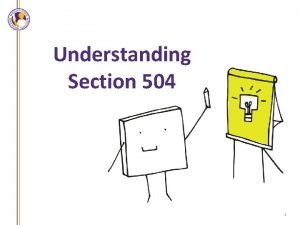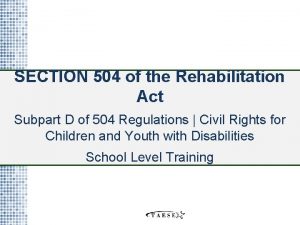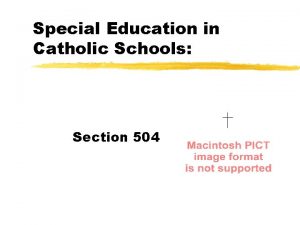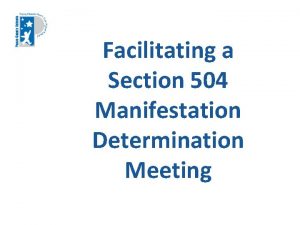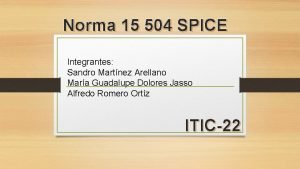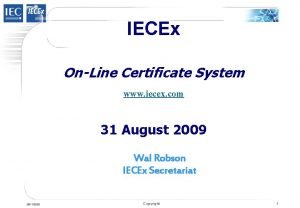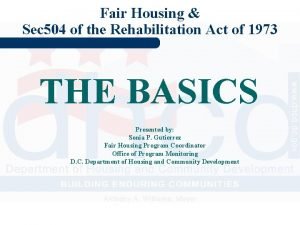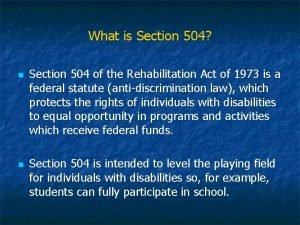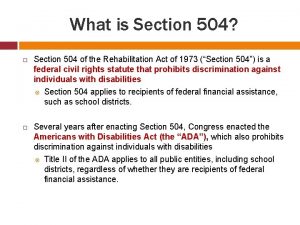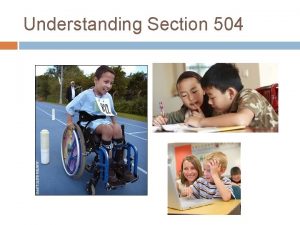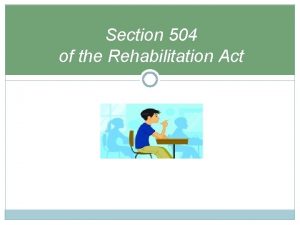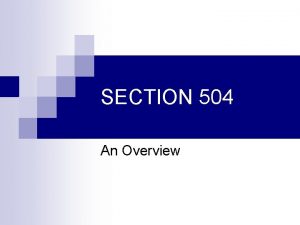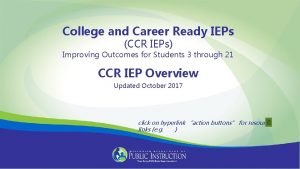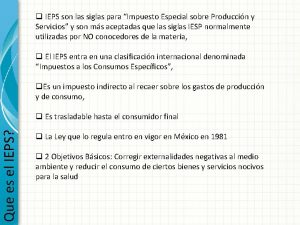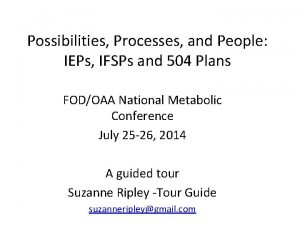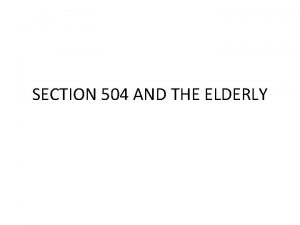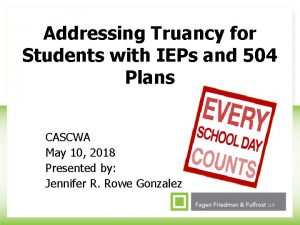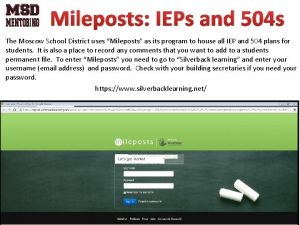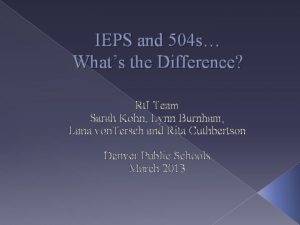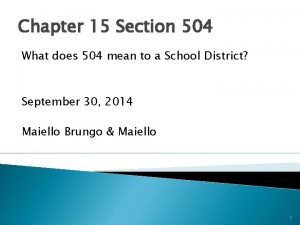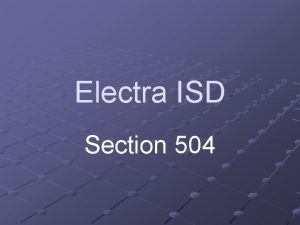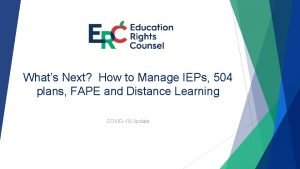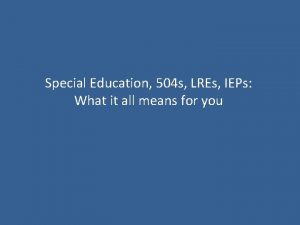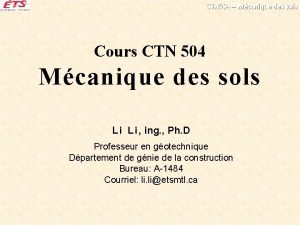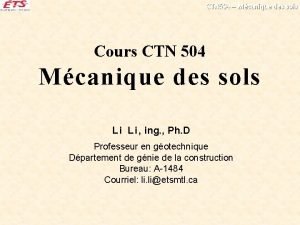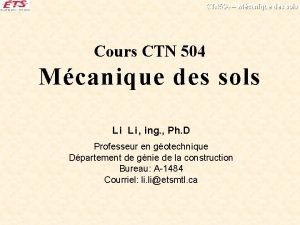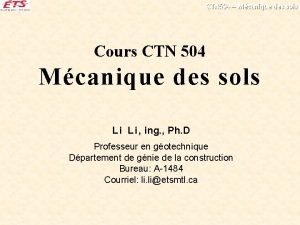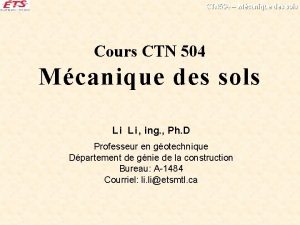The Legal Framework for IEPs and Section 504

















![Americans With Disabilities Act “[N]o qualified individual with a disability shall, by reason of Americans With Disabilities Act “[N]o qualified individual with a disability shall, by reason of](https://slidetodoc.com/presentation_image_h2/b0cd25474176c6f0f62e974a4693d706/image-18.jpg)


















































































- Slides: 100

The Legal Framework for IEP's and Section 504 Plans Melissa K. Waugh, J. D. , M. P. H. CASA Training February 4, 2021

The History of Special Education Law

Individuals with Disabilities Education Improvement Act of 2004 (IDEA) Education entitlement/funding law that evolved out of the Civil Rights Movement of the 1950’s and 1960’s This grant statute attaches many strings to the Federal funds it provides States for school dists. Requirement that a Free Appropriate Public Education (“FAPE”) be provided to children with disabilities in the Least Restrictive Environment (“LRE”) appropriate for the child

Individuals with Disabilities Education Improvement Act of 2004 (IDEA) Brown v. Bd. of Education (1954) ◦ The U. S. Supreme Court held “. . . in the field of public education the doctrine of ‘separate but equal’ has no place. Separate educational facilities are inherently unequal. ” ◦ Denial of equal protection of the laws guaranteed by the 14 th a. ◦ Parents began to sue schools for excluding children with disabilities and warehousing them in institutions Elementary and Secondary Education Act of 1965 ◦ Amended in 1966 to create a grant program for handicapped children ◦ This grant program was replaced in 1970 by the Education of the Handicapped Act ◦ Neither had mandates on the use of funds, nor showed any significant improvement in the education of children with disabilities

Individuals with Disabilities Education Improvement Act of 2004 (IDEA) PARC v. Commonwealth of Pennsylvania (1971) ◦ Class action brought by Penn. Assoc. of Retarded Children ◦ Consent agreement accepted by the Court ◦ Children with intellectual disabilities were entitled to a public education and could not be excluded from school without a prior hearing. Mills v. Bd. of Educ. of the Dist. of Columbia (1972) ◦ Class action brought by parents b/c children with disabilities were regularly excluded/suspended/expelled from public school with no due process ◦ Court held insufficient funds no excuse for school ◦ In detailed judgment, Court sketched out the rights that would soon be afforded parents and students under the IDEA

In the 2 years following these cases, there were an additional: ◦ 36 court cases in 24 States on the right to education for all handicapped children; ◦ 38 court cases in 25 States on the right of these children to due process; and ◦ 8 court cases in six States on the right of treatment for all children who need it. ◦ In those cases, judgments were rendered in favor of disabled children. 120 CONG. REC. 15261, 15270 (1974)

Congress Investigates and Finds 8 million disabled children in U. S. 1. 75 million excluded from schools altogether More than half received inappropriate educational services due to: § § § Lack of resources to provide appropriate services Failure to diagnose disabilities Segregation of students with disabilities in separate schools and classrooms away from their peers Pub. L. No. 94 -142, 89 Stat. 773, 774 -775 (1975).

Congress found “the long-range implications of these statistics are that public agencies and taxpayers will spend billions of dollars over the lifetimes of these individuals to maintain such persons as dependents and in a minimally acceptable lifestyle. ” “With proper education services, many would be able to become productive citizens. . . instead of being forced to remain burdens. ” Congress also found that “Parents of handicapped children all too frequently are not able to advocate for the rights of their children because they have been erroneously led to believe that their children will not be able to lead meaningful lives. ”

Congress recognized that school districts were woefully underfunded to provide the services necessary to meet their legal obligations to children with disabilities. Senator Mathias from Maryland noted that only 40% of the 7 million children in this country with disabilities were receiving an adequate education. In the 1974 reauthorization of the Elementary and Secondary Education Act of 1965, Congress authorized additional funding for programs for handicapped children and set the stage for the enactment of the IDEA. 120 CONG. REC. 15261, 15266 -15306 (1974)

Individuals with Disabilities Education Improvement Act of 2004 (IDEA) Education for All Handicapped Children Act (1975) ◦ Amended the Education of the Handicapped Act of 1970 ◦ Gave children with disabilities a right to a FAPE ◦ Substantially expanded funding on a permanent basis to ensure FAPE ◦ Funds to be used exclusively for ‘excess costs’ in educating children with disabilities ◦ Process for holding LEA’s accountable for providing educational services to handicapped children – procedural safeguards Amended several times--given the name IDEA in 1990; last amended in 2004

IDEA Purposes Ø To ensure that all children with disabilities have available to them a free appropriate public education (FAPE) Ø Emphasizing special education and related services designed to meet their unique needs and prepare them for further education, employment, and independent living 34 C. F. R. § 300. 1(a). Ø To ensure that the rights of children with disabilities and parents of such children are protected

IDEA Definition of FAPE Ø FAPE : special education and related services that are free, meet State and IDEA standards, include preschool/elementary/secondary education, and are provided pursuant to an IEP. 34 C. F. R. § 300. 17 Ø To get $, States must provide FAPE to children with disabilities between 3 -21 years old, including those who are hospitalized, have been suspended/expelled, or those who are incarcerated.

Rehabilitation Act of 1973, Section 504 Broad civil rights (non-discrimination) law that provided protection for people with disabilities for the first time in U. S. history Applies to programs receiving Federal funding (e. g. , public schools, trade schools, colleges, and universities) Unfunded mandate Unlike IDEA, it includes an anti-retaliation provision (34 C. F. R. § § 100. 7(e), 104. 61)

ORIGINAL TEXT OF SECTION 504: “No otherwise qualified handicapped individual in the United States, as defined in section 7(6), shall, solely by reason of his handicap, be excluded from the participation in, be denied the benefits of, or be subjected to discrimination under any program or activity receiving Federal financial assistance. ” 29 U. S. C. § 794 (2016)

Rehabilitation Act of 1973, Section 504 Originally introduced in 1972 as an amendment to the Civil Rights Act of 1964 Congress enacted this "handicapped rights" statute in section 504 of the Rehabilitation Act of 1973 However, no implementing regulations were issued between 1973 and 1977 Issued only after a lawsuit and a series of sit-ins and demonstrations by people with disabilities Kitty Cone, Short History of the 504 Sit In, DISABILITY RIGHTS EDUC. & DEF. FUND (2017), available at https: //dredf. org/504 -sitin-20 th-anniversary/short-history-of-the-504 sit-in/

There are specific regulations at 34 C. F. R. pt. 104 addressing: ◦ Employment Practices (Subpart B); ◦ Accessibility (Subpart C); ◦ Preschool, Elementary, and Secondary Education (Subpart D); ◦ Postsecondary Education (Subpart E); and ◦ Health, Welfare, and Social Services (Subpart F), which includes the education of institutionalized persons (§ 104. 54).

Section 504 is enforced by the Office of Civil Rights (“OCR”) within the U. S. Dept. of Education. ◦ Title VI of the Civil Rights Act of 1964 (prohibiting discrimination on the basis of race, color or national origin), ◦ Title IX of the Education Amendments of 1972 (prohibiting gender discrimination), ◦ Age Discrimination Act of 1975 (prohibiting age discrimination), ◦ Boy Scouts of America Equal Access Act, and ◦ Title II of the Americans with Disabilities Act of 1990 (“Title II”), which extends this prohibition against disability discrimination to the full range of state and local government services, programs, and activities regardless of whether they receive any Federal financial assistance.
![Americans With Disabilities Act No qualified individual with a disability shall by reason of Americans With Disabilities Act “[N]o qualified individual with a disability shall, by reason of](https://slidetodoc.com/presentation_image_h2/b0cd25474176c6f0f62e974a4693d706/image-18.jpg)
Americans With Disabilities Act “[N]o qualified individual with a disability shall, by reason of such disability, be excluded from participation in or be denied the benefits of the services, programs, or activities of a public entity, or be subjected to discrimination by any such entity. ” 42 U. S. C. § 12132; 28 C. F. R. § 35. 130(a))

Americans With Disabilities Act Ø President Bush signed into law on July 26, 1990 Ø It is a broad civil rights (non-discrimination) law that prohibits discrimination based on disability Ø Modeled after the Civil Rights Act of 1964 and Section 504 of the Rehabilitation Act of 1973 Ø Unfunded Ø Includes Ø Same mandate an anti-retaliation clause eligibility standard as Section 504 ØAmended in 2008 (ADAAA)

The Americans with Disabilities Act consists of five titles: • Title I - Employment - directed by the U. S. Equal Employment Opportunity Commission (EEOC); and the U. S. Department of Labor (DOL). • Title II - Public Services - (and public transportation) directed by the Federal Transit Administration (FTA); U. S. Department of Health and Human Services (HHS); U. S. Department of Education (ED); (ED) U. S. Department of Housing and Urban Development (HUD). • Title III - Public Accommodations - directed by U. S. Department of the Interior (DOI); U. S. Department of Agriculture (USDA). • Title IV - Telecommunications - directed by the Federal Communications Commission (FCC). • Title V - Miscellaneous Provisions

REMEDIES IDEA ◦ Prospective Relief Section 504/ADA ◦ Retrospective Relief Finding of eligibility Change in IEP Change in placement or preventing a change in placement Reversal of manifestation determination decision ◦ Monetary/compensatory damages Compensatory education Tuition reimbursement ◦ Attorney fees + costs ◦ Expert witness fees ◦ NO punitive damages ◦ Retrospective Relief ◦ Attorney fees + costs ◦ NO expert witness fees ◦ NO punitive damages Compensatory education Tuition reimbursement Intentional discrimination e. g. , bad faith/gross misjudgment NOTE: In both, school can recover litigation costs from parents when the underlying action is frivolous, unreasonable, or without foundation

Special Education Laws

Sources of Law Ø Federal statutes (IDEA, Rehab Act § 504, ADA, etc. ) Ø Federal regulations Ø Judicial decisions (federal and state) Ø State regulations Ø Guidance documents from federal and state departments of education (Office of Special Education Programs (OSEP), Office of Civil Rights (OCR), VA Dept of Educ (VDOE))

Who is Protected? IDEA v. Section 504/ADA

IDEA

IDEA Protection Ø Children ages 3 -21 (VA = 2 -22), unless graduated or receiving early intervention services Ø Found eligible by a multidisciplinary team within one or more of 13 specific disability categories Ø Who need special education and related services Ø Protection extends to students who have been expelled or suspended from school Ø Includes some children with disabilities who are incarcerated

IDEA Governing Principles Ø Child Find: duty to identify, locate, and evaluate all children with disabilities residing in Virginia Ø Parent Participation: must be meaningful Ø FAPE: free appropriate public education ØMeet the child’s unique needs ØConfer an educational benefit Ø LRE: least restrictive environment to the maximum extent appropriate Ø IEP: individualized education plan Ø Discipline: procedural safeguards

Child Find Ø Suspected disability = Student having trouble § low grades § problems reading or paying attention § repeated suspensions § poor behavior or fighting in school Ø A disability may be present even if a child is not failing and is passing from grade to grade

Child Find Ø If the school suspects a disability, it must do something: § Initiate an evaluation immediately § Refer to child study committee or other schoolbased team to decide whether to initiate an evaluation or begin pre-referral interventions (RTI) § BUT pre-referral interventions may not be used to delay evaluations Ø If the parent suspects a disability, s/he should request a special education evaluation in writing

Parent Participation Ø Winkelman (2007): S. Ct. held giving parents meaningful opportunities to participate in the education of their children would ensure that the goals of IDEA are carried out. Ø Parental Rights: § § to participate in the development of the child’s IEP to refuse consent to evaluation and services to request an independent educational evaluation (IEE) to seek relief through various dispute resolution mechanisms, including reimbursement of private school tuition Ø It can be a deprivation of FAPE if the school imposes significant impediments to the parents’ opportunity to participate.

The term ‘parent’ means– (A) a natural/biological, adoptive, or foster parent of a child (even if parents’ rights not terminated, but LEA must give written notice to parents at last known address); (B) a guardian (but not the GAL or State/DSS if the child is a ward of the State--foster child with no foster parent, or child in the custody of DSS); (C) an individual acting in the place of a natural or adoptive parent (including a grandparent, stepparent, or other relative) with whom the child lives, or an individual who is legally responsible for the child’s welfare; (D) a surrogate parent if no one above identified or willing to act as parent; or (E) a married or emancipated minor 20 USC § 1401(23) 34 CFR § 30 8 VAC 20 -81 -10

Parent Invitee Parent can invite any individual to be part of the IEP team and attend meetings. At the discretion of the parent or the agency, other individuals who have knowledge or special expertise regarding the child, including related services personnel as appropriate Some schools require a release be signed for them to participate 20 USC § 1414(d)(1)(B)(vi) 34 CFR § 300. 321(a)(6) 8 VAC § 20 -81 -110(C)(1)(f)

Evaluation Ø School must evaluate in ALL areas of suspected disability Ø School must get parental consent before evaluating Ø Complete evaluations and make eligibility decision in 65 business days § Clock also ticks over the summer! Ø School must give copies of evaluations to parent upon request § At least 2 business days prior to an eligibility meeting

Eligibility Ø Required members of eligibility committee: § Parent(s) § Qualified professionals (e. g. , social workers, mental health providers, attorneys, etc. ) § School evaluators, the special education administrator or designee § Others (group not limited to the above) Ø The eligibility decision must draw upon information from a variety of sources § § Is there a disability & does it adversely impact education? What is the split between achievement and ability? Grades? Attendance? Classroom functional performance? What special education and related services are needed?

IDEA Disability Categories Ø Other health impairments Ø Autism (e. g, ADHD, Anxiety) Ø Deaf-blindness* Ø Specific learning Ø Deafness disabilities* Ø Developmental delay (3 -9/2 -6) Ø Speech/language Ø Emotional disability impairments Ø Hearing impairments Ø Traumatic brain injury Ø Intellectual disabilities Ø Visual impairments Ø Multiple disabilities* Ø Orthopedic impairments * Does not require an adverse effect on educational performance

Independent Educational Evaluation (IEE) Ø IEE = Evaluation conducted by a qualified examiner not employed by the local educational agency (LEA) Ø Parent has the right to request an IEE, at public expense, if the parent “disagrees” with the LEA’s evaluation Ø LEA must provide the IEE “without unnecessary delay” or file due process complaint Ø Parent may choose any evaluator as long as the evaluator meets the requirements that the LEA applies to its own evaluators

IDEA FAPE Ø IDEA requires that a Free Appropriate Public Education (“FAPE”) be provided to children with disabilities in the Least Restrictive Environment (“LRE”) appropriate for the child Ø FAPE is defined as special education and related services provided pursuant to an Individualized Education Plan (“IEP”) Ø Special education and related services should be designed to meet children’s unique needs and prepare them for further education, employment, and independent living

IDEA FAPE Ø Bd. of Education v. Rowley (1982) Ø U. S. Supreme Ct. first addressed FAPE under IDEA Ø Amy Rowley; minimal residual hearing; excellent lipreader; fully integrated into a general education classroom; good grades; progressed from K to 1 st grade; understood less in class than peers Ø Parents wanted a sign language interpreter and school was offering an FM voice amplification system Ø U. S. Sup. Ct. rejected parent’s argument for “an equal educational opportunity” [Section 504/ADA standard], but found a substantive right to FAPE Ø 2 -prong test for FAPE : 1) procedural compliance; and 2) IEP “reasonably calculated to enable the child to receive educational benefits”

IDEA FAPE Ø Bd. of Education v. Rowley (1982) Ø IEP must be “likely to produce progress” but does not need to maximize potential (not the best education) Ø Doe v. Bd. of Educ. (6 th Cir 1993): school not required to provide a child with a Cadillac education—a servicable Chevrolet is all that IDEA requires Ø However, Court noted in a footnote that passing from grade to grade is not automatically a FAPE. Ø D. B. v. Bedford Co. Sch. Bd. (W. D. Va 2010): token advancement was a sad case of social promotion; IEP failed to provide FAPE because of evidence of insufficient progress and regression Ø IEP Team needs to look behind the grades and use multiple sources of information to determine if progress is being made and FAPE is being provided.

IDEA FAPE Ø Endrew F. v. Douglas Cty. School Dist. (2017) Ø Diagnosed with autism at age 2; by 4 th grade still exhibiting numerous maladaptive behaviors; parents privately placed; behaviors improved significantly and made more academic progress than in public school Ø ALJ/Dist. Ct. /10 th Cir. : “. . . the instruction and services furnished to children with disabilities must be calculated to confer ‘some educational benefit, ’” which means an IEP is adequate if “. . . it is calculated to confer an ‘educational benefit [that is] merely. . . more than de minimis. ’”

IDEA FAPE Ø Endrew F. v. Douglas Cty. School Dist. (2017) Ø U. S. Sup. Ct. noted: “. . . a student offered. . . ‘merely more than de minimis’ progress from year to year can hardly be said to have been offered an education at all. . The IDEA demands more. It requires an educational program reasonably calculated to enable a child to make progress appropriate in light of the child’s circumstances. ” Ø While not creating a “bright-line rule”, the Court clearly rejected the “more than de minimis” and “some educational benefit” standards developed by lower courts and raised the bar for a FAPE for children not fully mainstreamed.

IDEA FAPE Ø Endrew F. v. Douglas Cty. School Dist. (2017) Ø Reasonably calculated: prospective judgment Ø Make progress: “A substantive standard not focused on student progress would do little to remedy the pervasive and tragic academic stagnation that prompted Congress to act. ” Ø Potential for growth: new language requiring a prospective assessment of how much progress is reasonable to expect of this child in light of his circumstances---may effect private placement cases if child overperforms there

IDEA FAPE Ø Endrew F. v. Douglas Cty. School Dist. (2017) Ø Appropriately ambitious: Required for IEPs for children not fully integrated and not expected to pass from grade to grade. “[E]very child should have the chance to meet challenging objectives. ” Ø Cogent and responsive explanation: While deference to educational policies is still the rule, the Court expects schools to air these explanations throughout the development of the IEP.

IDEA FAPE Ø Endrew kept Prong 1 of Rowley—procedural violations can be a denial of FAPE Ø However, denial of FAPE only if the procedural violation (I) impeded FAPE; (II) significantly impeded the parents' opportunity to participate in the decision-making process regarding FAPE; or (III) caused a deprivation of educational benefits Ø M. C. v. Antelope Valley Union H. S. Dist. (9 th Cir. 2017): applying Endrew the Court held that school must implement an IEP reasonably calculated to remediate and accommodate the child’s disabilties taking into account the child’s potential Ø Future areas of disagreement: "potential" and "ambitious goals"

LRE Ø Child must be educated in the least restrictive environment to the maximum extent appropriate Ø The more the child is educated with non-disabled peers, the less restrictive the setting Ø LEA must provide a continuum of placements ranging from regular classroom to a special school to home-based tutoring Ø Regular class is default, so IEP must include an explanation of the extent to which the child will not participate with non-disabled children in the regular class

Individualized Education Program (IEP) Ø It’s the “primary vehicle” by which schools and parents decide how to deliver FAPE in LRE Ø Basic Components: – Present Performance (PLOP) – How is the child doing academically, behaviorally, and functionally? – Annual goals – What should the child be able to do by the end of the year? Academic and functional goals – Accommodations – What program modifications or supports are needed? Good place to reference BIPs – Services – What special education, related services, or supplementary aides & services needed to: • Help the child attain annual goals • Help the child be involved in and make progress in the general curriculum & extracurricular/nonacademic activities; AND • Ensure it happens in the LRE 8 VAC 20 -81 -110(G)

Individualized Education Program (IEP) Ø Transition Services • Designed to facilitate the child’s movement from school to • • • college, work, or independent living Transition services must begin no later than the first IEP drafted in the year when the child will turn 16 years old. VA=14 yrs. old The IEP team must review age-appropriate transition assessments related to training, education, employment, and, where appropriate, independent living skills. The IEP team must develop appropriately ambitious and measurable postsecondary goals; and identify transition services (including courses of study) that will enable the student to make progress toward those goals in light of the student’s individual circumstances. Must invite student and participating agency to IEP meeting where transition goals or services will be discussed (e. g. , DARS)

IEP and Placement Ø Hold IEP meeting within 30 calendar days of eligibility decision Ø Include parent Ø Work with the parent towards consensus Ø Write the IEP based on the child’s needs, not on the available placements or services Ø Provide a placement in the least restrictive environment to the maximum extent appropriate (“LRE”)

Implementation & Revision Ø The school must: • Implement ALL elements of IEP. Implementation • • failures may be challenged in due process if a denial of FAPE. Parent is entitled to periodic progress reports at least as often as grades are sent to all students Ensure the child’s IEP is reviewed & revised not less than annually Reevaluate children at least every 3 years or when child’s parent or teacher requests reevaluations (but should not conduct same evaluation more than once per year) Evaluate a child before changing eligibility

Discipline of Students with Disabilities Ø Students with disabilities receive extra protection under IDEA from disciplinary exclusion. Ø If a regular ed student is suspended/expelled, the district owes no education to that student —exempt from compulsory education. Ø If a special ed student is suspended/expelled, the district still owes the child FAPE, even if the child has not yet been found eligible for special education, but subsequently is.

Discipline of Students with Disabilities Ø Short-term removal is a removal ≤ 10 school days. Ø School must provide due process protections afforded to all students (notice + hearing) Ø Apply the same sanction you would to a nondisabled student Ø Change in placement is a removal > 10 consecutive school days (or shorter periods of repeated removals constituting a pattern) Ø School must provide: § due process provided to all students + § manifestation determination review hearing + § services during removal

Is the behavior a manifestation of the disability? ØWas the behavior caused by the disability? ØWas the behavior directly & substantially related to the disability? OR ØWas the behavior the direct result of the school’s failure to implement the IEP? ØIf answer “YES”, the behavior is a manifestation of the child’s disability and the school must: § Return the child to the original placement (unless the parents/school agree otherwise) § Conduct a Functional Behavior Assessment (FBA) and develop a Behavior Intervention Plan (BIP) § If a BIP was already in place, review and modify it as necessary.

EXAMPLES: Ø Evals say child is very impulsive and doesn’t think through consequences before acting, then an impulsive act might be caused by the disability. Ø Eval says child has poor verbal communication skills and uses non-verbal, sometimes aggressive, behavior to communicate distress, then maybe it is directly and substantially related to the disability. Ø If a child’s IEP sets a goal to improve coping skills, and those skills are not taught, and the child acts out as a result of something going on at home, the bahavior could be a direct result of failure to implement the IEP. Also look at BIP to see if school implemented.

Dangerousness Exceptions Ø If the behavior is a manifestation of the disability, then the child cannot be removed from the placement unless: Ø Child possessed or carried weapons or drugs to school; or Ø Child inflicted serious bodily injury on another person while at school or school function; or Ø Hearing officer or judge has determined the child is too dangerous to remain at school. Ø The child may then be removed to an interim alternative educational placement for up to 45 days, but must still receive FAPE/services.

No Manifestation Ø If the conduct is NOT a manifestation of the student’s disability, the school may change the student’s placement, but MUST provide FAPE during removal, and as appropriate, provide a FBA/BIP Ø Services during removal MUST start on the 11 th day of removal and allow the student: Ø To make progress on IEP goals AND Ø To participate in the general curriculum although in another setting

MDR Hearing Issues School only looks at Disability Category and not disabilities School ignores symptomatology reflected in evaluations “He knew what he was doing” – not the standard of review for MDR

Termination Ø Special education services may be terminated when: Ø Child turns 22 (but can finish school year) Ø Child graduates with a regular/adv. diploma (not GED) Ø Child overcomes disability (e. g. , child with a developmental delay catches up or learns how to cope with attention deficit) Ø Unless the child ages out or graduates with a regular or advanced diploma, evaluations must be performed and parent must give consent before a change in eligibility

Common Special Ed Disputes Eligibility (e. g. , failure in Child Find, ignoring expert reports/dx) Failure to Provide an Appropriate Education (e. g. , IEP not individualized or not research based) Failure to Implement the IEP (e. g. , supports and services in IEP not provided) Inappropriate Discipline (e. g. , zero tolerance policy—school suspends even though manifestation of disability)

Tuition Reimbursement – 2 Options At IEP meeting, before removing child: ◦ You must state your concerns, and ◦ You must state your intent to enroll your child in a private program at public expense 10 business days before removing child, write a letter to the school stating: ◦ Your specific concerns, in detail, about the inadequacy of the school’s IEP and/or placement ◦ Your basis for rejecting the IEP ◦ Why your child will be damaged if placed in the school’s proposed program ◦ A statement of your intent to enroll your child in a private program at public expense

IDEA Dispute Resolution: 4 Options Ø Informal resolution Ø State complaint to VDOE • Can Be Made By ANYONE • Formal Complaint (written, signed, statement of violation) • Schools Submit Response • Investigation by VDOE • 60 days to VDOE decision • 1 -year statute of limitations Ø Mediation Ø Due process hearing (appeal to state or federal court)

Stay Put Ø “Stay Put”: during the litigation (beginning from filing of the due the child stays in the current educational placement process hearing request), Ø Current educational placement: Ø Where all services on IEP can be provided Ø If all services on IEP can’t be replicated, it’s a change in placement Ø No “stay put” for disciplinary/MDR appeals; stay in alternative setting until hearing officer decision issues or time expires, unless parents/school agree otherwise

Mediation Formal request—by school after both parents and school agree to mediate Voluntary for all parties—can walk away With qualified, impartial mediators appointed by VDOE—no cost to parent Can’t delay due process hearing Confidential Legally binding and enforceable agreement

Due Process Hearing A due process hearing is an evidentiary hearing on the record before an impartial hearing officer May be requested by parent or school; burden of proof falls on party bringing the complaint 2 -year statute of limitations (unless misrepresentation; sometimes lack of rights in native language) Issues not raised in the complaint can’t be raised at the hearing

Due Process Hearing Due process is available to resolve disputes relating to: ◦ Identification (child find, eligibility, change in eligibility, termination of any service) ◦ Evaluation ◦ Educational placement and services ◦ FAPE Hearing officers have authority to: ◦ Issue subpoenas (enforcement through Circuit Court) ◦ Exclude certain evidence & testimony ◦ Enter disposition on every issue

Due Process Hearing HO appointed in 5 days Response from school required within 10 days Resolution meeting: 15 calendar days after notice of filing DP request/complaint ◦ Schools’ attorneys present at resolution meeting only if parents’ attorneys present ◦ If resolved at Resolution Session: Written, signed settlement Either side can void it within 3 business days Confidentiality—not mandatory but parties can enter into an agreement to make the resolution session confidential

Due Process Hearing Officer Decision: ◦ ◦ In writing Findings of fact & conclusions Nonexpedited hearing— 45 days after Resolution Period Expedited hearing (disciplinary)— 20 days Transcript/recording Appeal: 90 days to federal court or 180 days to state court

Section 504

Rehabilitation Act of 1973 - Section 504 § Broad civil rights (non-discrimination) law that applies to schools and colleges receiving public funding § Accommodations, modifications, services, and improved building accessibility to provide access to education § Eligibility: physical or mental “impairment” that “substantially limits” one or more major life activities § If don’t need special education services, still eligible under Section 504 (e. g. , diabetic child with insulin issues; child with a nut or bee allergy) § A “Section 504 Plan” does not have to be written and does not require parental consent– legally enforceable § Legal remedies if a school district discriminates, excludes, or retaliates against a parent, child or school district employee exercising their rights (OCR complaint or federal court)

Section 504 Services/Accommodations Ø Section 504 requires that students with disabilities be given comparable aids, benefits, and services to those provided to nondisabled students in LRE Ø Includes music, physical education, lunch, services of the guidance office, or vocational training programs offered through the high school Ø Unlike with IDEA where the Supreme Ct. rejected this comparative/equal standard. Bd. of Educ. Of the Hendrick Hudson Central Sch. Dist. v. Rowley, 458 U. S. 176, 198 (1982), Endrew F. ex rel. Joseph F. v. Douglas Cnty. Sch. Dist. RE-1, 137 S. Ct. 988, 1001 (2017)

Section 504 Protection Protects a qualified individual with a disability: 1. a physical or mental impairment that substantially limits one or more major life activities of such individual; 2. a record of such an impairment; or 3. being regarded as having such an impairment Applies to all ages (no FAPE for postsecondary) Applies whether need special education or not; but FAPE only applies to those in Prong 1 Excludes individuals currently engaging in illegal drug use, unless in a rehab program and no longer engaging in illegal drug use

Section 504 FAPE Different standard from IDEA ◦ Section 504 equality standard rejected in Rowley & Endrew IDEA: focus on meeting individual needs of the student; affirmative duty to educate Section 504: providing educational services that are equivalent to those offered nondisabled students; comparative obligation; equal access to education received by nondisabled peers; prohibition against discrimination

Section 504 FAPE Section 504 regulations require that public schools provide FAPE to each qualified handicapped person Free: includes cost of transportation and residential placements Appropriate Education: regular or special education and related aids/services designed to meet the individual educational needs of disabled as adequately as the needs of nondisabled, AND compliance with Section 504 procedural requirements

Section 504 FAPE In addition to equal academic opportunities, students with a disability must receive: ◦ Equal opportunity to participate in athletics ◦ Equal opportunity to participate in extracurricular activities ◦ Freedom from bullying and harassment based on disability.

Section 504 Discrimination Ø Section 504 prohibits schools from: • • Denying a student with disabilities the opportunity to participate in or benefit from any aid, benefit, or service-the comparable opportunities requirement that includes nonacademic and extracurricular activities; Giving a student with disabilities an aid, benefit, or service that is not equal to that afforded others; Providing a student with disabilities with an aid, benefit, or service that is not as effective as that provided to others; or Otherwise limiting a student with disabilities in the enjoyment of any right, privilege, advantage, or opportunity enjoyed by others receiving an aid, benefit, or service. 34 C. F. R. § 104. 4(b)

Section 504 Discrimination Ø If a school offers to pay for a PSAT for its students, students with disabilities cannot be excluded from this benefit. Ø A school may not ban students with disabilities from participating in vocational training opportunities simply because they have a disability. Ø The educational needs of most students with disabilities to practice for the SAT or to learn vocational skills is the same as for nondisabled students and must be addressed as adequately as they are addressed for a nondisabled student.

Section 504 Discrimination Ø However, please note that Circuit courts have held that in order to prove intentional discrimination in the educational context, a parent must show something more than just the discrimination. Ø For example, in the 4 th Circuit, a parent must show either bad faith or gross misjudgment in order to prevail on a Section 504 claim

Section 504 Eligibility under Section 504 requires a “physical or mental impairment” that “substantially limits one or more major life activity. ” 34 C. F. R. § 104. 3 The ADA Amendments Act of 2008 expanded the scope of protection: ◦ Question of whether an individual is disabled should not demand extensive analysis ◦ Ameliorating effects of mitigating measures (other than eyeglasses or contacts) may not be considered ◦ Scope of “major life activities” is expanded and nonexhaustive ◦ An impairment that is episodic or in remission is a disability if it would substantially limit a major life activity when active ◦ Clarification of how law applies to someone “regarded as” having a disability

Substantially Limits Unfortunately, the term “substantially limits” is not defined The determination of whether an impairment substantially limits a major life activity is made on a case-by-case basis by a Section 504 Team using a variety of sources. (34 C. F. R. § 104. 35(c)) OCR has said “A student. . . would not be [eligible] if the impairment does not in any way limit the student's ability to learn or other major life activity, or only results in some minor limitation in that regard. ” Activities are restricted as to the condition, manner or duration under which they can be performed in comparison to most people.

Substantially Limits It is not enough to simply rely on a medical diagnosis or doctor’s note on a prescription pad. The school must consider other sources of information such as teacher observations, tests and evaluation data, and input from the school nurse, therapists, and the parents. In addition, the school can not simply rely on a student’s grades in making a determination.

Substantially Limits In passing the ADAAA, Congress rejected the assumption that an individual with a specific learning disability who performs well academically cannot be substantially limited in activities such as learning, reading, writing, thinking, or speaking. H. R. Rep. No. 110 -730, pt. 1, at 15 (2008) Grades do not provide information on how much effort or how many outside resources are required for the student to achieve those grades Students should not be penalized because of adaptive strategies or accommodations that lessen the deleterious impacts of their disability

Substantially Limits OCR has addressed, more than once, the issue of grades in determining whether a child is disabled under 504 Using the example of a child with dyslexia who spends more time preparing for class than other students and earns good grades because of the student’s intelligence and extreme efforts, OCR says still substantially limited in the major life activity of reading. Parent and Educator Resource Guide to Section 504 in Public Elementary and Secondary Schools (2016) In a local complaint resolution, OCR said “. . . grades alone are a single source evaluation and do not necessarily accurately distinguish subsets of skills in a subject area or reflect how a student achieved the grades. ” Virginia Beach (VA) City Public Schools, 54 IDELR 202, 3 (OCR 2009)

Mitigating Measures In the ADAAA Congress specifically rejected several U. S. Sup. Ct. cases that allowed for consideration of mitigating measures when determining eligibility under Section 504 Examples: medication, medical equipment and devices, prosthetic limbs, low vision devices, hearing aids, mobility devices, oxygen therapy equipment, use of assistive technology, reasonable accommodations, auxillary aids or services, and learned behavioral or adaptive neurological modifications. 42 U. S. C. § 12102(4)(E) Excludes eyeglasses and contacts This list is not exhaustive

Mitigating Measures Mitigating measures also include informal educational interventions/accommodations including: preferential seating, “check-off” lists, nonverbal cues, chunking, books on tape, reading interventions, a token system, repeating instructions, bathroom privileges, excused tardies, extra time to make up missed work and home instruction. See Benjamin Logan (OH) Local Sch. District, 113 LRP 24739, 3, 10, 15 (OCR 3/7/13). Would the child be substantially limited if these interventions or accommodations were not in place? 504 Teams should also consider the negative effects (e. g. , side effects of medication) in determining if an individual is substantially limited in a major life activity.

Major Life Activities The list of major life activities under Section 504 includes, but is not limited to: Caring for oneself Performing manual tasks Seeing Hearing Eating Sleeping Walking Standing Lifting Bending Speaking Breathing Learning Reading Concentrating Thinking Communicating Working 42 U. S. C. § 12102(2)(A) 34 C. F. R. § 104. 3 (j)(2)(ii)

Major Bodily Functions Major bodily functions are also considered major life activities, and include but are not limited to: Functions of the immune system Normal cell growth Digestive Bowel Bladder Neurological Brain Respiratory Circulatory Endocrine Reproductive functions 42 U. S. C. § 12102(2)(A) 34 C. F. R. § 104. 3 (j)(2)(ii)

Major Life Activities Ø A disability does not have to impact learning, academic performance, or the abiltiiy to attend class in order to qualify under 504. Ø OCR has clarified that schools need to consider how an impairment affects any major life activity and not just the activity of learning Ø In several Letters of Findings from complaint investigations, OCR has expressed concern when schools limit their consideration of a major life activity to only one activity, such as learning

Discipline Under Section 504 OCR interprets Section 504 as requiring the same disciplinary protections as the IDEA when a student is subjected to a "significant change in placement” OCR interprets this as suspended or expelled for >10 days (consecutive or cumulative) <10 days - same disciplinary sanction used for non-disabled students >10 days a reevaluation is triggered with OCR says includes an MDR -- conducted in substantially the same way as IDEA If the MDR team determines the misconduct is related to a disability--reassess Section 504 Plan and placement to determine if still appropriate--consider new or revised FBA/BIP Can impose same sanction as that for a non-disabled student

Section 504 Enforcement Ø Section 504 is enforced by the Office of Civil Rights (“OCR”) within the U. S. Department of Education Ø Anyone (e. g. , parent, student, or advocate) can file a complaint with OCR for violations of Section 504 within 180 calendar days of the date of the alleged discrimination---opportunities for settlement Ø OCR will not review the content of Section 504 Plans, IEPs, individual placements, or other educational decisions---must file for a Section 504 or IDEA due process hearing Ø OCR will review identification/evaluation of students, procedural safeguards, and incidents where students with disabilities are treated differently

Section 504 Enforcement Ø At any time, an individual may file a Federal lawsuit Ø Unlike IDEA, there is no exhaustion requirement unless the plaintiff also seeks relief for a denial of FAPE Ø Fry v. Napoleon Comm. Sch. (2017): U. S. Sup. Ct. 2 -part test to determine whether a claim is related to FAPE Ø Could the claim be brought if it occurred in a library or public theater? Ø Could an adult, as opposed to a child, press the same claim against the school?

Title II of the Americans With Disabilities Act (“ADA”)

Title II of the ADA Ø Schools must take any action required to ensure SWD receive the same benefits and services offered to nondisabled students that does not fundamentally alter the nature of the program or impose an undue financial or administrative burden. 28 C. F. R. § 35. 130(b)(7)(i) (generally); 28 C. F. R. § 35. 150 (a)(2) - (a)(3) (facilities); 28 C. F. R. § 35. 164 (communication). Ø Special rules for equal access to school facilities and auxiliary aids and services to meet communication needs.

ADA Discrimination Ø ADA regulations prohibit a School Board from engaging in any of the following discriminatory actions: ◦ Deny an opportunity to participate in or benefit from any aid, benefit, or service” ◦ Give an aid, benefit, or service that is not equal ◦ Provide an aid, benefit, or service that is not as effective ◦ Limit the enjoyment of any right, privilege, advantage, or opportunity enjoyed by others ◦ Administer/establish requirements for a licensing or certification program that discriminates against a student with disabilities

o o o Fail to make reasonable modifications in policies, practices, or procedures necessary to avoid discrimination, unless it would fundamentally alter the nature of the service, program, or activity Impose/apply eligibility criteria that screen out disabled individuals from fully and equally enjoying any service, program, or activity, unless necessary to provide the service, program, or activity Fail to provide services, programs, and activities in the most integrated setting appropriate (similar to LRE) Impose a surcharge to cover the costs of measures required to comply with the ADA Impose safety requirements that are based on mere speculation, stereotypes, or generalizations rather than actual risks to safety. 28 C. F. R. § 35. 130(b), (d), (f), (h)

ADA Discrimination Ø Same heightened standard as in Section 504 cases Ø A parent must show something more than just the discrimination. Ø In the 4 th Circuit, that is either bad faith or gross misjudgment

Resources


VDOE Guidance Documents

OCR & OSEP Guidance Documents

SPED Organizations https: //peatc. org/ www. copaa. org https: //www. yellowpagesforkids. com/ https: //www. facebook. com/spedparentallies

Contact Information Melissa K. Waugh, JD, MPH Belkowitz Law, PLLC 10427 North Street, Suite 200 Fairfax, VA 22030 (703) 246 -9270 office (434) 660 -4707 direct line (703) 246 -9271 fax mwaugh@belkowitzlaw. com
 Ieps colfontaine
Ieps colfontaine Section 502 guaranteed rural housing loan program
Section 502 guaranteed rural housing loan program Section 504 home repair program
Section 504 home repair program Section 504
Section 504 Bridge loan
Bridge loan Section 504
Section 504 Staubgrenzwert
Staubgrenzwert Idea vs 504
Idea vs 504 Proceso de factorizacion de 504
Proceso de factorizacion de 504 Universal design for learning definition
Universal design for learning definition Celiac 504 plan
Celiac 504 plan 504 plan catholic schools
504 plan catholic schools Html 504
Html 504 Manifestation meeting for 504
Manifestation meeting for 504 Norma 504
Norma 504 Iecex.com
Iecex.com Sec 504
Sec 504 Legal and regulatory framework of microfinance in india
Legal and regulatory framework of microfinance in india How to explain conceptual framework
How to explain conceptual framework Iso 22301 utbildning
Iso 22301 utbildning Novell typiska drag
Novell typiska drag Tack för att ni lyssnade bild
Tack för att ni lyssnade bild Vad står k.r.å.k.a.n för
Vad står k.r.å.k.a.n för Shingelfrisyren
Shingelfrisyren En lathund för arbete med kontinuitetshantering
En lathund för arbete med kontinuitetshantering Personalliggare bygg undantag
Personalliggare bygg undantag Tidbok för yrkesförare
Tidbok för yrkesförare Anatomi organ reproduksi
Anatomi organ reproduksi Vad är densitet
Vad är densitet Datorkunskap för nybörjare
Datorkunskap för nybörjare Stig kerman
Stig kerman Att skriva en debattartikel
Att skriva en debattartikel Autokratiskt ledarskap
Autokratiskt ledarskap Nyckelkompetenser för livslångt lärande
Nyckelkompetenser för livslångt lärande Påbyggnader för flakfordon
Påbyggnader för flakfordon Tryck formel
Tryck formel Offentlig förvaltning
Offentlig förvaltning Urban torhamn
Urban torhamn Presentera för publik crossboss
Presentera för publik crossboss Argument för teckenspråk som minoritetsspråk
Argument för teckenspråk som minoritetsspråk Kanaans land
Kanaans land Klassificeringsstruktur för kommunala verksamheter
Klassificeringsstruktur för kommunala verksamheter Mjälthilus
Mjälthilus Claes martinsson
Claes martinsson Cks
Cks Programskede byggprocessen
Programskede byggprocessen Mat för unga idrottare
Mat för unga idrottare Verktyg för automatisering av utbetalningar
Verktyg för automatisering av utbetalningar Rutin för avvikelsehantering
Rutin för avvikelsehantering Smärtskolan kunskap för livet
Smärtskolan kunskap för livet Ministerstyre för och nackdelar
Ministerstyre för och nackdelar Tack för att ni har lyssnat
Tack för att ni har lyssnat Referatmarkering
Referatmarkering Redogör för vad psykologi är
Redogör för vad psykologi är Borstål, egenskaper
Borstål, egenskaper Tack för att ni har lyssnat
Tack för att ni har lyssnat Borra hål för knoppar
Borra hål för knoppar Vilken grundregel finns det för tronföljden i sverige?
Vilken grundregel finns det för tronföljden i sverige? Varians formel
Varians formel Tack för att ni har lyssnat
Tack för att ni har lyssnat Steg för steg rita
Steg för steg rita Informationskartläggning
Informationskartläggning Tobinskatten för och nackdelar
Tobinskatten för och nackdelar Toppslätskivling dos
Toppslätskivling dos Handledning reflektionsmodellen
Handledning reflektionsmodellen Egg för emanuel
Egg för emanuel Elektronik för barn
Elektronik för barn Plagg i gamla rom
Plagg i gamla rom Strategi för svensk viltförvaltning
Strategi för svensk viltförvaltning Kung som dog 1611
Kung som dog 1611 Humanitr
Humanitr Sju för caesar
Sju för caesar Tack för att ni lyssnade
Tack för att ni lyssnade Multiplikation med uppställning
Multiplikation med uppställning Dikt med fri form
Dikt med fri form Inköpsprocessen steg för steg
Inköpsprocessen steg för steg Fuktmätningar i betong enlig rbk
Fuktmätningar i betong enlig rbk Ledarskapsteorier
Ledarskapsteorier Expektans eller exspektans
Expektans eller exspektans Myndigheten för delaktighet
Myndigheten för delaktighet Frgar
Frgar Sju principer för tillitsbaserad styrning
Sju principer för tillitsbaserad styrning Läkarutlåtande för livränta
Läkarutlåtande för livränta Brant karttecken
Brant karttecken Geometri för barn
Geometri för barn Shivaiter
Shivaiter Vad är vanlig celldelning
Vad är vanlig celldelning Bris för vuxna
Bris för vuxna Jätte råtta
Jätte råtta Dispositional framework vs regulatory framework
Dispositional framework vs regulatory framework Theoretical framework vs conceptual framework
Theoretical framework vs conceptual framework Conceptual framework theoretical framework
Conceptual framework theoretical framework Dispositional framework vs regulatory framework
Dispositional framework vs regulatory framework Theoretical framework
Theoretical framework Hình ảnh bộ gõ cơ thể búng tay
Hình ảnh bộ gõ cơ thể búng tay Frameset trong html5
Frameset trong html5 Bổ thể
Bổ thể Tỉ lệ cơ thể trẻ em
Tỉ lệ cơ thể trẻ em Voi kéo gỗ như thế nào
Voi kéo gỗ như thế nào Chụp tư thế worms-breton
Chụp tư thế worms-breton Alleluia hat len nguoi oi
Alleluia hat len nguoi oi



